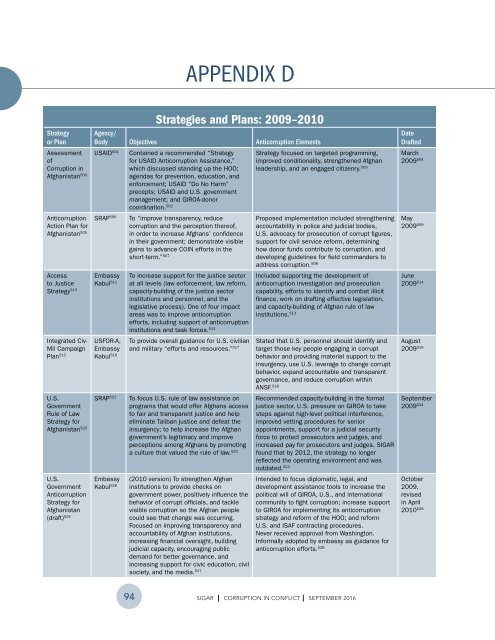CORRUPTION IN CONFLICT
5IlaWjQej
5IlaWjQej
You also want an ePaper? Increase the reach of your titles
YUMPU automatically turns print PDFs into web optimized ePapers that Google loves.
APPENDIX D<br />
Strategy<br />
or Plan<br />
Assessment<br />
of<br />
Corruption in<br />
Strategies and Plans: 2009–2010<br />
Agency/<br />
Body Objectives Anticorruption Elements<br />
Strategy focused on targeted programming,<br />
for USAID Anticorruption Assistance,” improved conditionality, strengthened Afghan<br />
which discussed standing up the HOO; leadership, and an engaged citizenry. 503<br />
agendas for prevention, education, and<br />
enforcement; USAID “Do No Harm”<br />
precepts; USAID and U.S. government<br />
management; and GIROA-donor<br />
coordination. 502<br />
Afghanistan 500 USAID 501 Contained a recommended “Strategy<br />
Anticorruption<br />
Action Plan for<br />
Afghanistan 505 SRAP 506 To “improve transparency, reduce<br />
corruption and the perception thereof,<br />
in order to increase Afghans’ confidence<br />
in their government; demonstrate visible<br />
gains to advance CO<strong>IN</strong> efforts in the<br />
short-term.” 507<br />
Access<br />
to Justice<br />
Strategy 510<br />
Integrated Civ-<br />
Mil Campaign<br />
Plan 515<br />
U.S.<br />
Government<br />
Rule of Law<br />
Strategy for<br />
Afghanistan 520<br />
U.S.<br />
Government<br />
Anticorruption<br />
Strategy for<br />
Afghanistan<br />
(draft) 525<br />
Embassy<br />
Kabul 511<br />
USFOR-A,<br />
Embassy<br />
Kabul 516<br />
SRAP 521<br />
Embassy<br />
Kabul 526<br />
To increase support for the justice sector<br />
at all levels (law enforcement, law reform,<br />
capacity-building of the justice sector<br />
institutions and personnel, and the<br />
legislative process). One of four impact<br />
areas was to improve anticorruption<br />
efforts, including support of anticorruption<br />
institutions and task forces. 512<br />
To provide overall guidance for U.S. civilian<br />
and military “efforts and resources.” 517<br />
To focus U.S. rule of law assistance on<br />
programs that would offer Afghans access<br />
to fair and transparent justice and help<br />
eliminate Taliban justice and defeat the<br />
insurgency; to help increase the Afghan<br />
government’s legitimacy and improve<br />
perceptions among Afghans by promoting<br />
a culture that valued the rule of law. 522<br />
(2010 version) To strengthen Afghan<br />
institutions to provide checks on<br />
government power, positively influence the<br />
behavior of corrupt officials, and tackle<br />
visible corruption so the Afghan people<br />
could see that change was occurring.<br />
Focused on improving transparency and<br />
accountability of Afghan institutions,<br />
increasing financial oversight, building<br />
judicial capacity, encouraging public<br />
demand for better governance, and<br />
increasing support for civic education, civil<br />
society, and the media. 527<br />
Proposed implementation included strengthening<br />
accountability in police and judicial bodies,<br />
U.S. advocacy for prosecution of corrupt figures,<br />
support for civil service reform, determining<br />
how donor funds contribute to corruption, and<br />
developing guidelines for field commanders to<br />
address corruption. 508<br />
Included supporting the development of<br />
anticorruption investigation and prosecution<br />
capability, efforts to identify and combat illicit<br />
finance, work on drafting effective legislation,<br />
and capacity-building of Afghan rule of law<br />
institutions. 513<br />
Stated that U.S. personnel should identify and<br />
target those key people engaging in corrupt<br />
behavior and providing material support to the<br />
insurgency, use U.S. leverage to change corrupt<br />
behavior, expand accountable and transparent<br />
governance, and reduce corruption within<br />
ANSF. 518<br />
Recommended capacity-building in the formal<br />
justice sector, U.S. pressure on GIROA to take<br />
steps against high-level political interference,<br />
improved vetting procedures for senior<br />
appointments, support for a judicial security<br />
force to protect prosecutors and judges, and<br />
increased pay for prosecutors and judges. SIGAR<br />
found that by 2012, the strategy no longer<br />
reflected the operating environment and was<br />
outdated. 523<br />
Intended to focus diplomatic, legal, and<br />
development assistance tools to increase the<br />
political will of GIROA, U.S., and international<br />
community to fight corruption; increase support<br />
to GIROA for implementing its anticorruption<br />
strategy and reform of the HOO; and reform<br />
U.S. and ISAF contracting procedures.<br />
Never received approval from Washington.<br />
Informally adopted by embassy as guidance for<br />
anticorruption efforts. 528<br />
Date<br />
Drafted<br />
March<br />
2009 504<br />
May<br />
2009 509<br />
June<br />
2009 514<br />
August<br />
2009 519<br />
September<br />
2009 524<br />
October<br />
2009,<br />
revised<br />
in April<br />
2010 529<br />
94 SIGAR I <strong>CORRUPTION</strong> <strong>IN</strong> <strong>CONFLICT</strong> I SEPTEMBER 2016


